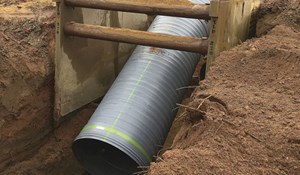Los Angeles stormwater infrastructure proves resilient as Tropical Storm Hilary breaks records
(UI) — Tropical Storm Hilary's recent journey through Southern California and Nevada on August 20 made history as one of the wettest storms the region has ever witnessed, even though it didn't cause the extensive destruction initially feared, according to the Stormwater Report.
This tropical storm shattered single-day summer precipitation records in several California cities, including San Diego, Los Angeles, and Palm Springs. In a few short hours, Hilary delivered more rainfall to Death Valley than the area typically receives in an entire year. Furthermore, even as the storm weakened while passing through California, it still holds the record as the wettest tropical storm ever documented in Nevada, Idaho, Montana, and Oregon.
For water agencies in Los Angeles County, which have invested heavily in stormwater capture projects in recent years, the unusually intense storm presented both challenges and opportunities.
As of August 29, the aftermath of the storm was still under assessment, but Bowen Xie, spokesperson for the Los Angeles Department of Water and Power, told the Stormwater Report that the city's infrastructure alone managed to capture approximately 13 million cubic meters (10,500 acre-feet) of water from Tropical Storm Hilary. This volume of water is sufficient to meet the needs of approximately 40,000 households for a year.
Anticipating Hilary's arrival and its potential path, forecasters urged officials in California and neighboring states to prepare for the worst. On August 19, California Governor Gavin Newsom declared a state of emergency, mobilizing thousands of emergency response personnel, expediting the installation of new flood pumps in vulnerable areas, and evacuating populations at risk from the storm's expected path. In Los Angeles, eight emergency shelters hastily opened their doors as the U.S. National Hurricane Center issued its first-ever tropical storm watch for Southern California, predicting that the storm would bring more than a year's worth of rain to the region within hours.
Hilary initially made landfall as a Category 1 hurricane in Baja California Sur, Mexico, on August 20, causing severe flooding and at least one fatality. After briefly retreating into the Pacific Ocean and weakening, it re-emerged as a tropical storm just north of the U.S.-Mexico border later that evening. This marked Hilary as the first tropical storm to affect Southern California in over 80 years, a region currently in the midst of its annual dry season.
Throughout Hilary's duration, dramatic videos depicting flooded roads and mudslides circulated online. Some cities, including Palm Springs, temporarily lost access to their 911 communication lines. Overall, AccuWeather estimates that Hilary caused up to $9 billion in damages and economic losses, making it one of the costliest storms in the region's history.
The impressive stormwater capture performance in Los Angeles during Hilary can be attributed in large part to the Los Angeles County Flood Control District's Safe, Clean Water Program (SCWP). This program has supported the design and construction of over 250 stormwater projects throughout Los Angeles County, collectively valued at more than $1.3 billion.
The SCWP was established in November 2018 after Los Angeles County voters approved "Measure W," a $0.27 per square meter ($0.025 per square foot) parcel tax on impermeable surfaces within the Los Angeles County Flood Control District's boundaries. This tax, collected from over 2.1 million taxable parcels in the most populous county in the U.S., provides approximately $280 million annually earmarked specifically for stormwater management projects. Half of these funds support regional-scale interventions in Los Angeles County, while 40% are allocated among the 86 municipalities within the district to aid local-scale infrastructure projects. The remaining 10% is allocated to public water conservation education, water workforce development, and program management.
According to SCWP data, the new stormwater infrastructure constructed since the passage of Measure W has enabled the capture and reuse of nearly 74 million cubic meters (60,000 acre-feet) of stormwater annually on average. More than half of this water is collected from the Upper Los Angeles River watershed. Noteworthy projects include the addition of on-site collection and treatment capabilities in schools, parks, and recreation centers. SCWP also supports innovative stormwater treatment facilities like the Long Beach Municipal Urban Stormwater Treatment Project, set to commence operations in the near future.
In addition to SCWP-funded infrastructure projects, other recent initiatives aimed at better managing stormwater runoff played a crucial role in Los Angeles' response to Hilary. For instance, the Los Angeles County Department of Public Works estimates that its Ballona Creek Trash Interceptor 007 project prevented over 7,250 kilograms (16,000 pounds) of trash and debris, mobilized by the storm, from reaching Santa Monica Bay and the Pacific Ocean. This interceptor, a fully automated, solar-powered barge situated at the mouth of one of the city's most pollution-prone waterways, resulted from a pioneering partnership between the county and The Ocean Cleanup in Delft, The Netherlands. This initiative, which incurred no cost to Los Angeles taxpayers, has significantly reduced the city's contribution to marine waste associated with major storms since its installation in October 2022.
This story was originally published by the Stormwater Report.
Related News
From Archive

- Glenfarne Alaska LNG targets late-2026 construction start for 807-mile pipeline project
- U.S. water reuse boom to fuel $47 billion in infrastructure spending through 2035
- $2.3 billion approved to construct 236-mile Texas-to-Gulf gas pipeline
- Major water pipe break in Puerto Rico hits over 165,000 customers
- Potomac River Tunnel project enters construction phase beneath Washington, D.C.
- Pennsylvania American Water launches interactive map to identify, replace lead water service lines
- Trump's tariffs drive $33 million cost increase for Cincinnati sewer project
- Utah city launches historic $70 million tunnel project using box jacking under active rail line
- Tulsa residents warned after sewer lines damaged by boring work
- Fatal trench collapse halts sewer construction in Massachusetts; two workers hospitalized




Comments